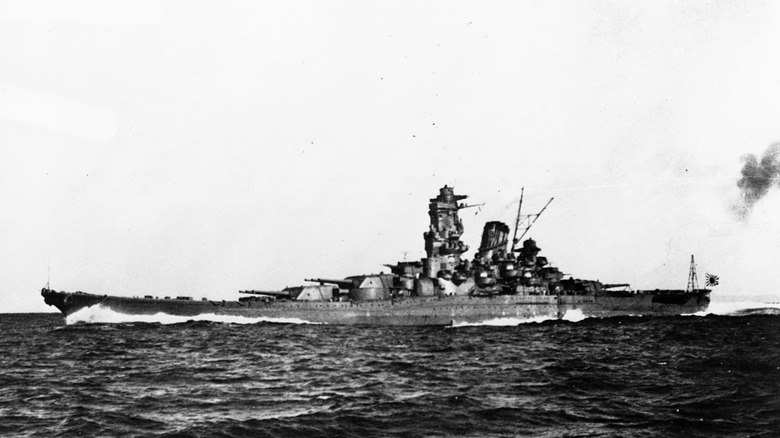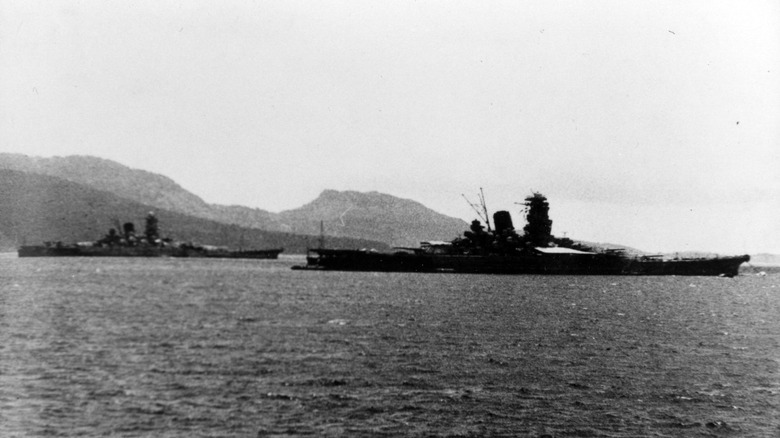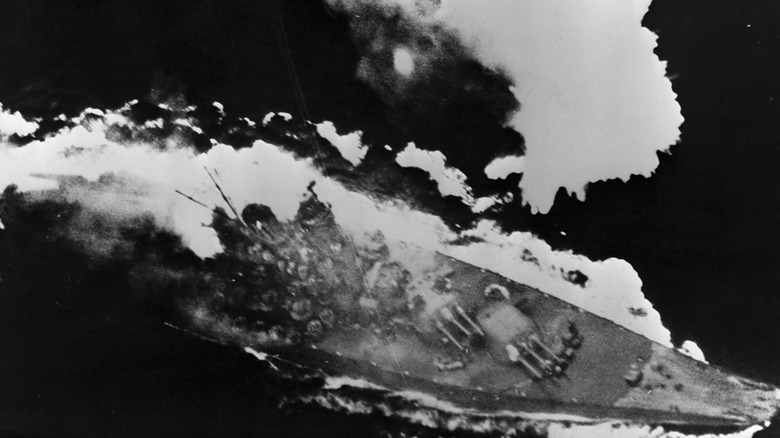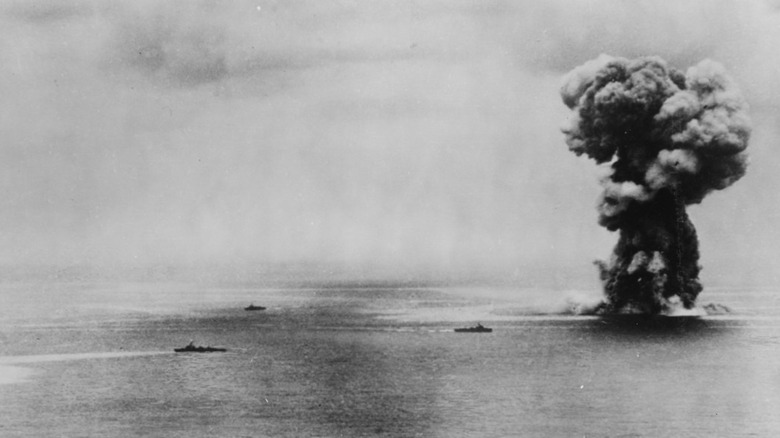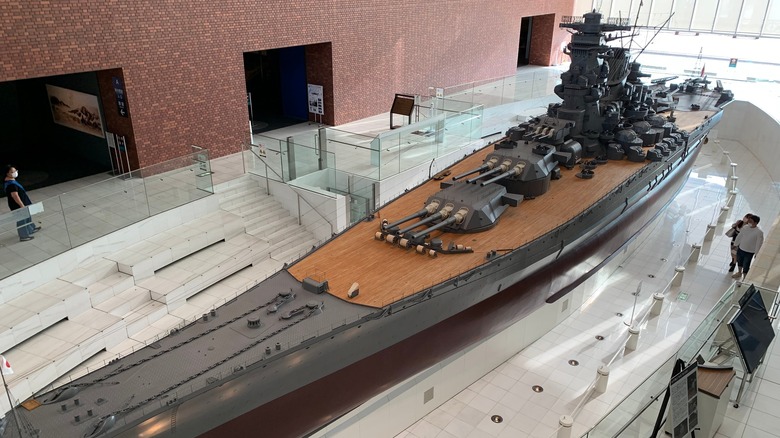Yamato: The Sinking Of Japan's Largest Battleship
Prior to the days of Tomahawk missiles and aircraft carriers, battleships were the way a nation would flex its muscles at sea. In 1941, as the Imperial Japanese Navy was in the midst of its dash across the Pacific islands, it commissioned the battleship Yamato as its flagship. Over 80 years later, the Yamato remains the largest and heaviest battleship ever constructed, displacing a total of 72,000 tons. It was 863 feet long.
If sheer size wasn't enough, the Yamato bristled with guns of every size, from 25-millimeter anti-aircraft guns to a total of nine 18.1 inch deck guns. The U.S. Naval History and Heritage Command estimates that the main guns of the Yamato had a range of 22 miles when firing 3,200 pound shells. To put that into perspective, that's the equivalent of launching a projectile that weighs as much as a Toyota Corolla over the visible horizon. To make matters more concerning for Allied naval forces, the Yamato had a nearly identical sister ship named the "Musashi" and a planned third ship. However, the Musashi sank in 1944 and the third, hastily converted to an aircraft carrier and dubbed "Shinano," was torpedoed by the USS Archerfish submarine.
The pride of the fleet
Inside the Yamato were 12 boilers that allowed its four engines to generate 150,000 hp and propel the ship to a comparatively lightning fast 32 miles per hour. The steel surrounding vital parts of the ship's superstructure and armaments was 25 inches thick. If it wasn't associated with the Imperial Japanese, the Yamato would be considered one of the finest pieces of military equipment ever made.
The Imperial Navy revered the Yamato and it had great cultural significance. Its bow was emblazoned with the Japanese chrysanthemum and the name "Yamato" itself is an historic moniker for the people of Japan. It carried with it an implacable mystique. That mystery was perpetuated by the fact that the Yamato never saw very much combat and played more of a cameo appearance in battles against Allied forces. Namely, those gargantuan guns only managed to sink two American ships during the battle that sank the Musashi.
At 70 tons of fuel an hour, the Yamato was thirsty and given the perpetually resource strapped nature of the Imperial Navy, the Yamato literally couldn't afford to be in a prolonged fight. Still, Allied forces weren't going to wait around at the gas pump for the Yamato to fill its tank. It was anything but harmless.
Operation Heaven Number One
By the Spring of 1945, time was running out for Imperial Japan in nearly every conceivable metric. Air defenses were basically nonexistent after U.S. Naval forces crippled any hope of getting planes in the air and fielding more aircraft carriers at the Battle of Midway. After island hopping, the Allied forces were getting too close for comfort, and the Japanese-held islands needed to be protected at all costs, starting with the island of Okinawa. The Yamato, a symbol of Imperial might seemed like the perfect option to defend its home turf.
The Yamato's final mission, "Operation Heaven Number One" ("Ten-ichi-go" in Japanese) was relatively simple, despite its lofty name. It was to full steam towards Okinawa and beached itself on the island to fight as a stationary gun platform until every last shell was fired. Captain Kosaku Aruga and Vice Admiral Seiichi Ito both took on the fateful mission that started on March 29th.
The end of the Yamato
On the morning of April 7th, the Yamato was spotted making its dash towards the island as the United States was getting its response ready, which included around 390 aircraft by the end of the day, each one carrying enough bombs and torpedoes to give the Imperial Japanese Navy a hard time, especially considering the fact that the Yamato and surrounding ships only just ten total aircraft at its disposal.
But the Yamato wasn't going down without swinging. As the hours went on, the ship zigzagged all over the Pacific and emptied thousands of anti-aircraft shells into the sky to ward off attacking planes. But it was ultimately no use. Nearly six hours after being spotted, the Yamato had received the punishment of a total of 11 torpedoes and six bombs. After a heavy list and capsizing, the final torpedo struck the compartment where all of the Yamato's ammunition was held. The resulting explosion was reportedly visible upwards of 100 miles away and the ship cracked in half and disappeared under the waves, bringing with it Captain Aruga and Vice Admiral Ito and 3,055 sailors. U.S. Naval Forces lost 12 pilots in the engagement.
The Yamato's legacy
The Yamato was unique compared to other warships from the era, not only because it was the largest battleship on the sea. It was different in that it embodied the entire Imperial Japanese war effort into a single vessel. It was incredibly advanced and deadly when it was first introduced. Much like Japan, the Yamato was low on resources for most of its time at sea. And lastly, it fought until the bitter end. The Yamato's crew was not going to give up without either completing its doomed mission, or going down with the ship.
Due to the incredibly violent nature of its sinking and the overall fog of battle in the Pacific Theater, the Yamato itself wasn't found for more than 40 years in 1985 and confirmed in 1999. As expected, the ship was in multiple heaps of metal at the bottom of the Pacific and even its famous 18.1-inch guns left their mount in the sinking. Today, in Kure, Japan, there's a museum dedicated to the ship, complete with a 1:10 scale model of the former pride of the Imperial Navy.
